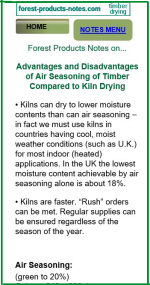Forest Products Notes on...
Timber Kiln Drying Equipment
The commonest type of timber drying kilns are “heat and vent” type “compartment kilns” which dry timber in batches:
Heat and Vent timber kilns
These can be categorised by the location of the fans used to circulate the air. Thus there are:
Overhead Fan type timber kilns:-
Longitudinal shaft type (below): utilising a number of fans on a longitudinal, driven shaft.
Diagrams showing operation of longitudinal (above) and cross shaft design kilns
Cross shaft type (above):- this type is the most popular in UK. One or more fans
is used to circulate the air through the stickered stack of timber.
A 3m3 capacity overhead cross-
Side Fan type: these are also popular:-
Construction of Timber Drying Kilns
Originally, compartment kilns were built of brick (cavity-
Kilns should always be run full to reduce air "short-
The NEXT PAGE of these notes is our most popular page, as it compares air seasoning of timber with kiln drying of timber and in particular the Advantages and Disadvantages of Air Seasoning of Timber compared to Kiln Drying...




To learn more about the theory underpinning kiln drying of timber (temperature, relative humidity and airflow see the PREVIOUS PAGE: Kiln Drying of Timber

